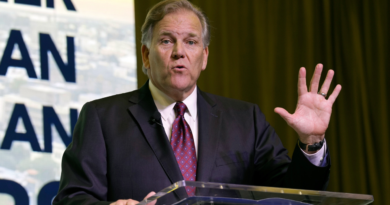Ope, sorry: Midwestern House Dems push for leaders between the coasts
The sight stunned many lawmakers. Within hours, her map was in front of President Joe Biden. Dingell lost her leadership race, to a Californian no less, but she’s breaking through with her call for the party to home in on the middle of the country or risk losing ground in 2024.
“Debbie’s message was a really important one,” said Rep. Dean Phillips (D-Minn.), a fellow Midwesterner. “That map, essentially, is the evidence that our adversaries have been using against us for some time now, which is: We’re the coastal party.”
Dingell is launching what she’s dubbed the Heartland Caucus, a group of Democrats who plan to advocate on manufacturing, trade and other economic issues that they see as critical to repairing their party’s tarnished brand back home. Midwestern Democrats are banding together at a critical time, with their region hosting several must-win Senate races next year as the party prepares to elevate Michigan in its White House primary ballot — but at the expense of Iowa, another heartland state.
“You can’t live in the bubble here,” said Dingell, who famously predicted that Donald Trump would win in 2016 as Democrats lost ground with voters in her home state. After losing her bid for caucus vice chair last week, Dingell said: “I went to bed on Wednesday night and said Thursday morning: We’re starting this.”
One big motivator behind her new group: The number of Democrats outside the coasts who will lead the party on a House committee next year can be counted on one hand. The party’s top five incoming leaders hail from New York, Massachusetts, California and South Carolina. It’s part of a huge, party-wide shift over the last two decades, when Missouri’s Richard Gephardt and Michigan’s David Bonior once helped steer House Democrats.
“California always has a seat, in fact, quite a few seats, and so does New York. And then we have Boston,” said Rep. Marcy Kaptur (D-Ohio), who’s been involved in forming the caucus. “And it’s like, what about us?”
The Ohio Democrat cited a recent tiff she had with fellow Democrats on the caucus’ special committee on economic fairness. Kaptur said she had to “fight and fight and fight” to get her region’s economic plight represented in the group’s final report this week. But in the panel’s 30-minute documentary, she said she couldn’t get the Midwest mentioned at all.
“I’m angry about that. Ask Jim Himes, the chairman of the committee from Greenwich, Connecticut,” Kaptur said. She said when she described the struggles of working class people in Lorain, Ohio, or Flint, Michigan, or Kenosha, Wis., “The attitude of some on the committee was, ‘Oh well, let them move.’”
While many Midwesterners said their current crop of leaders supports their high-priority issues, they remain concerned by the shortage of regional voices in the party’s upper ranks. And those members warn that a lack of geographic diversity among top policymakers can have serious electoral consequences.
“We end up with policy decisions that don’t reflect the Midwest. And so we end up losing elections very badly in the Midwest,” Rep. Bill Foster (D-Ill.) said of his area’s lack of representation among committee leaders. “I think it’s something that’s sort of become a self-fulfilling prophecy.”
The exact boundaries of the forthcoming Heartland Caucus aren’t entirely clear yet — fittingly, since the very definition of the Midwest itself is a famously contentious topic. Lawmakers involved with launching the caucus said they plan to initially rely on the dozen states included in the Census Bureau’s definition, a square chunk of map that stretches from the Dakotas and Kansas to Ohio.
But organizers of the group said they’ve also fielded membership requests from Democrats in western Pennsylvania, northern New York and even rural parts of California, whose districts often behave more like the Midwest than their colleagues’ urban bases along either coast. (The group won’t formally launch until the next Congress.)
Dingell and her fellow Michiganders did get one big win this week: Biden made a concerted push for the Mitten to become one of the party’s first five presidential primary states, boosting its prospects of formal elevation in the party’s schedule. It was the culmination of a 30-year quest by Dingell and the state’s late senator Carl Levin — and a sign to many Democrats that the president himself sees their path to keeping the White House running straight through the region.
“Michigan is really a microcosm of the country in so many ways. You have to win it to win,” said Rep. Andy Levin (D-Mich.), Carl Levin’s nephew and a longtime witness to the fight.
Still, other Midwestern Democrats noted that Michigan’s success came at the expense of Iowa — where the party badly lost a Senate race this fall in addition to its sole House seat.
That Iowa seat, where Rep. Cindy Axne fell short last month, is one of several pro-Trump Midwest districts that House Democrats relinquished thanks to a combination of losses and retirements. Also on the list: rural seats held by retiring Reps. Ron Kind (D-Wis.) and Cheri Bustos (D-Ill.).
Bustos, who has sat at Pelosi’s leadership table for several terms now as the last Midwesterner in House Democrats’ upper ranks, encouraged her colleagues to keep prioritizing rural America after she, Axne and others leave the Hill.
The region will gain some leadership representation, with Phillips and Rep. Lauren Underwood (D-Ill.) taking on lower-tier roles next Congress as co-chairs of the caucus messaging arm. But Bustos, among other Democrats, stressed the importance of pushing for more.
“Having a seat at the leadership table really, really matters,” Bustos said. “I think it’s harmful overall to Congress and to our nation if we don’t have a loud enough voice representing rural America and the Midwest.”
Ally Mutnick contributed.




